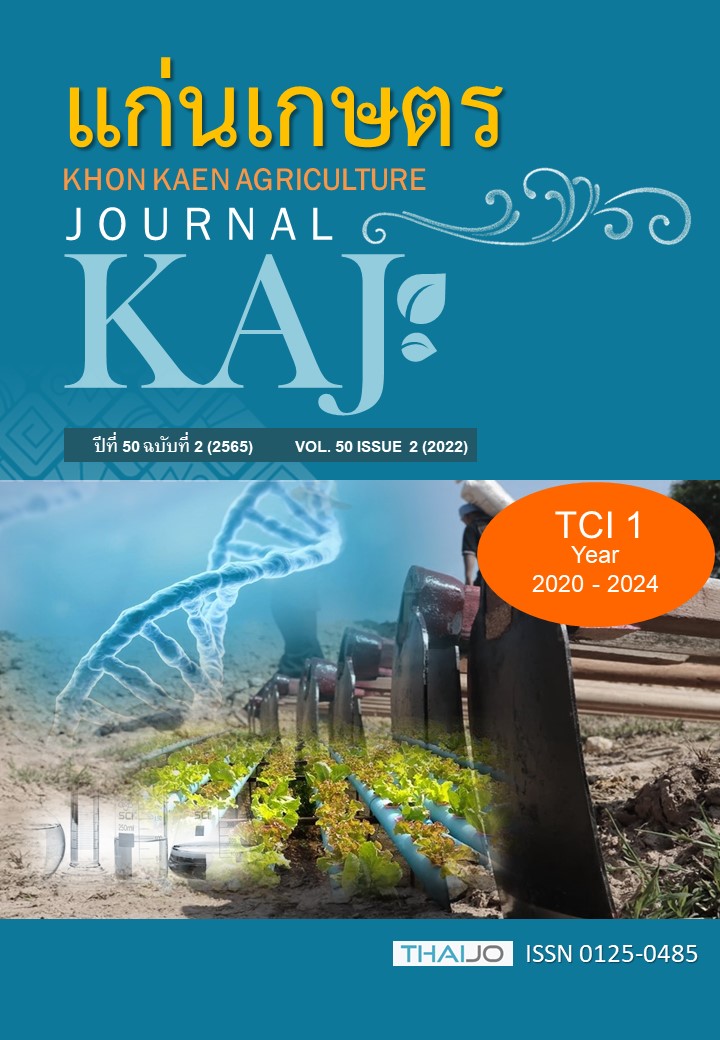ความดีเด่นของลูกผสมและการคัดเลือกสายพันธุ์ทนร้อนในผักกาดขาวปลี
Main Article Content
บทคัดย่อ
ผักกาดขาวปลีเป็นผักที่เพาะปลูกกันอย่างแพร่หลายในพื้นที่ภาคเหนือตอนบน และในฤดูหนาว เนื่องจากต้องการอากาศเย็นเพื่อกระตุ้นให้ห่อหัว ผักชนิดนี้ได้รับความนิยมในการบริโภคทั้งในและต่างประเทศ การศึกษาครั้งนี้มีจุดประสงค์ เพื่อคัดเลือกสายพันธุ์ลูกผสมผักกาดขาวปลีที่มีความดีเด่นเหนือพ่อแม่พันธุ์ และมีลักษณะทนร้อนเหมาะสำหรับการผลิตในประเทศไทย วางแผนการทดลองแบบสุ่มสมบูรณ์ในบล็อค (randomized complete block design: RCBD) จำนวน 30 คู่ผสม สายพันธุ์พ่อแม่ 6 พันธุ์ และพันธุ์การค้า 2 สายพันธุ์ กรรมวิธีละ 3 ซ้ำ ระหว่างเดือนเมษายน-มิถุนายน 2563 จากผลการทดลองพบว่า 3 คู่ผสมที่มีแนวโน้มที่ดีได้แก่ PR4 x PR1, PR3 x PR1 และ PR2 x PR6 สามารถห่อหัวได้ในฤดูร้อน รูปทรงของหัวยาว โดยมีค่าดัชนีหัวตั้งแต่ 1.5 และให้ผลผลิตหลังตัดแต่งสูงกว่าพันธุ์การค้า และคู่ผสมอื่น ๆ ในขณะที่พันธุ์การค้านั้นไม่ห่อหัว นอกจากนี้ยังพบว่า คู่ผสม PR1 x PR2, PR2 x PR6, PR3 x PR1, PR4 x PR1 และ PR6 x PR3 มีค่าความดีเด่นเหนือพ่อแม่พันธุ์ทางบวกในทุกลักษณะที่ศึกษา ได้แก่ ความสูงต้น ทรงพุ่ม จำนวนใบ ความกว้างใบ ความยาวใบ น้ำหนักก่อนตัดแต่ง และน้ำหนักหลังตัดแต่ง จากการทดลองนี้ชี้ให้เห็นว่าคู่ผสมหลายคู่มีศักยภาพที่ดีในการนำไปพัฒนาลูกผสมเพื่อใช้เพาะปลูกในประเทศไทย สามารถห่อหัวได้ตลอดทั้งปี และให้ผลผลิตหลังตัดแต่งสูง ตลอดจนมีลักษณะของหัวที่ดี ตรงตามความต้องการของผู้บริโภค
Article Details

อนุญาตภายใต้เงื่อนไข Creative Commons Attribution-NonCommercial-NoDerivatives 4.0 International License.
เอกสารอ้างอิง
กรุง สีตะชะนีม ,วิษณุ อภิชาติพัฒนศิริ, ธีรพล ครุฑรังสิต, ธีรวัฒน์ กษิรวัฒน์, เฉลย ดวงตา, สมภาส เสียงใหญ่ และ กนกพันธ์ นิติพันธุ์. 2528. การทดสอบพันธุ์ผักกาดขาวปลีทนร้อน. โครงการพัฒนาพืชผักสู่ชนบท มหาวิทยาลัยเกษตรศาสตร์ กำแพงแสน, นครปฐม, กรุงเทพฯ.
กฤษฎา สัมพันธารักษ์. 2546. ปรับปรุงพันธุ์พืช: พื้นฐาน วิธีการ และแนวคิด. ภาควิชาพืชไร่นา คณะเกษตร มหาวิทยาลัยเกษตรศาสตร์, สำนักพิมพ์มหาวิทยาลัยเกษตรศาสตร์, กรุงเทพฯ.
วารสารเคหะการเกษตร. 2562. ส่องผักนำเข้าจากจีน ศึกหนักของผักไทย. แหล่งข้อมูล: https://www.kehakaset.com/ newsactivities_details.php?view_item=436#view_newsactivity_detail ค้นเมื่อ 2 สิงหาคม 2564.
ธีรวัฒน์ สีทอง. 2563. การประเมินพ่อและแม่พันธุ์เพื่อการผลิตลูกผสมชั่วที่ 1 ของผักกาดเขียวปลี. วารสารเกษตร. 30(2): 111-119.
มณีฉัตร นิกรพันธุ์. 2545. กะหล่ำ. โอเดียนสโตร์, กรุงเทพฯ.
สำนักงานเศรษฐกิจการเกษตร. 2564. มูลค่าเศรษฐกิจการเกษตร. แหล่งข้อมูล: http://oaezone.oae.go.th/view/1/ปัจจัยการผลิต/TH-TH ค้นเมื่อ 2 สิงหาคม 2564.
Aleem, S., I. Sharif, E. Amin, M. Tahir, N. Parveen, R. Aslam, M. Najeebullah, M. Tasdiq, and M.T.H. Shahid. 2020. Heat tolerance in vegetables in the current genomic era: an overview. Plant Growth Regulation. 96: 1-20.
Arncken, C., and H. Dierauer. 2005. Hybridsorten im Bio-Getreide? Perspektiven und Akzeptanz der Hybridzüchtung für den Bio-Anbau. Schlussbericht, Juni 2005 Coop Naturaplan-Fonds Biosaatgutprojekt Modul 1.4. Forschungsinstitut für biologischen Landbau, Frick, Switzerland.
Bita, C.E., and T. Gerats. 2013. Plant tolerance to high temperature in a changing environment scientific fundamentals and production of heat stress-tolerant crops. Frontiers in Plant Science. 4: 1-18.
Chen, L., X. Kong, R. Wang, S. Ma, Y. Meng, Q. Lu, and L. Zhang. 2021. Heterosis of plant gross weight and heterotic group classification of inbred lines in Chinese cabbage (Brassica rapa L. ssp. pekinensis). Scientia Horticulturae. 280: 109938.
Chen, X., W. Sorajjapinum, S. Reiwthongchum, and P. Srinives. 2003. Identification of parental mungbean lines for production of hybrid varieties. CMU Journal. 2(2): 97-105.
East, E.M., and G.H. Shull. 1908. Inbreeding in corn. Principle of Plant Breeding. John, Wiley and Sons, Inc, United States.
Kallo, G., and M. Rana. 1993. Chinese cabbage: Brassica pekinensis, B. chinensis. In Genetic Improvement of Vegetable Crops. Pergamon Press, New York, United States.
Kim, Y.Y., S.H. Oh, W. Pang, X. Li, S.J. Ji, E. Son, and Y.P. Lim. 2017. A review of the scientific names of Chinese cabbage according to the international codes of nomenclature. Horticultural Science & Technology. 35(2): 165-169.
IBPGR. 1987. Descriptors for Brassica campestris L. International Board for Plant Genetic Resources, Rome.
Kibar, B., O. Karaagac, and H. Kar. 2015. Heterosis for yield contributing head traits in cabbage (Brassica oleracea var. capitata). International Journal of Agriculture and Natural Resources. 42(2): 205-216.
Li, P., T. Su, D. Zhang, W. Wang, X. Xin, Y. Yu, and F. Zhang. 2021. Genome-wide analysis of changes in miRNA and target gene expression reveals key roles in heterosis for Chinese cabbage biomass. Horticulture Research. 8(1): 1-15.
Lin, K.H., H.C. Huang, and C.Y. Lin. 2010. Cloning, expression and physiological analysis of broccoli catalase gene and Chinese cabbage ascorbate peroxidase gene under heat stress. Plant Cell Reports. 29(6): 575-593.
Lorenz, O.A. 1964. Response of Chinese cabbage to temperature and photoperiod. Proceedings of the American Society for Horticultural Science. 47: 309-319.
Motoki, K., Y. Kinoshita, and M. Hosokawa. 2019. Non-vernalization flowering and seed set of cabbage induced by grafting onto radish rootstocks. Frontiers in plant science. 9: 1967.
Oh, S., K.H. Moon, I.C. Son, E.Y. Song, Y.E. Moon, and S.C. Koh. 2014. Growth, photosynthesis and chlorophyll fluorescence of Chinese cabbage in response to high temperature. Korean Journal of Horticultural Science and Technology. 32: 318-329.
Opena, R.T., and S.H. Lo. 1979. Genetics of heat tolerance in heading Chinese cabbage. Horticultural Science. 14: 33-34.
Park, H.J., W.Y. Jung, S.S. Lee, J.H. Song, S.Y. Kwon, H. Kim, and H.S. Cho. 2013. Use of heat stress responsive gene expression levels for early selection of heat tolerant cabbage (Brassica oleracea L.). International journal of molecular sciences. 14(6): 11871-11894.
Park, S. U., Y. B. Chung, S. H. Park, H. W. Park, and E. S. Han. 2018. Quality characteristics and kimchi processing ability of kimchi cabbage cultivars ‘Cheonjincheongmayeop’and ‘Chunkwang’. Korean Journal of Food Preservation, 25(2): 189-194.
Purseglove, J.W. 1968. Tropical Crops Dicotyledon I. Longmans, Green & co Ltd, London.
Shinohara, S. 1981. Principle of Vegetable Seed Production. JICA. Japan.
Xie, C.T., Y.H. Yang, Y.L. Qiu, X.Y. Zhu, and H.Q. Tian. 2005. Cytochemical investigation of genic male-sterility in Chinese cabbage. Sexual plant reproduction. 18(2): 75-80.
Xie, F., J. Zha, H. Tang, Y. Xu, X. Liu, and Z. Wan. 2018. Combining ability and heterosis analysis for mineral elements by using cytoplasmic male-sterile systems in non-heading Chinese cabbage. (Brassica rapa). Crop and Pasture Science. 69(3): 296-302.
Yuan, Y.X., X.W. Zhang, J.F. Geng, W.S. Jiang, and Y.P. Han. 2004. Yuxin 60-a new early-maturing Chinese cabbage hybrid. Acta Horticulturae Sinica. 31(5): 704.


